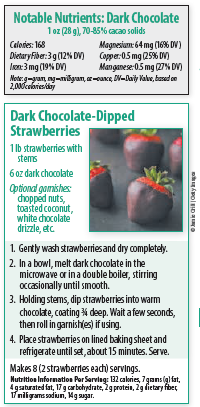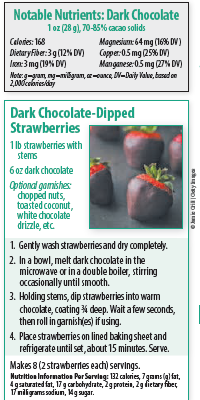Dark Chocolate
The Folklore. What better time of year to treat your Valentine (and yourself!) to the ultimate gift that’s both from and maybe even for the heart—dark chocolate. Dating back to 2000 BC, long before it represented romance and indulgence, the Mayans enjoyed it as a fermented drink mixed with spices or wine. Higher levels of antioxidant flavanols, which may protect the heart, are what set dark chocolate apart from other types. Fortunately, its health benefits long outlast the fleeting effect of Cupid’s arrows, so enjoy this heart-shaped indulgence all year long.
The Facts. Chocolate is made from beans harvested from the cocoa tree, Theobroma cacao. Once removed from their pod, fermented, dried, roasted, and ground into cocoa liquor, the beans are further processed into cocoa butter and cocoa powder. Cocoa liquor, cocoa butter, sugar, and vanilla are then combined to make chocolate. Dark chocolate contains at least 60 percent cocoa solids, higher levels of flavanols than other types of chocolate, and little or no added sugar. A one-ounce serving (about three thin squares from a bar of chocolate) contains 12% DV (DV=Daily Value, based on 2,000 calories/day) of dietary fiber, 19% DV of energy-supporting iron, and 16% DV of heart-healthy magnesium.
The Findings. Flavanols in cocoa and dark chocolate have been linked with many positive health effects, including heart, diabetes, mood, and a host of other benefits. Though many studies have linked dark chocolate to improved cardiovascular health, a recent systematic review of studies in the journal Nutrients (2021) found that, compared to controls, cocoa or chocolate consumption significantly improved triglycerides, but there were no significant improvements to other positive health outcomes. However, a more recent study published in a 2022 issue of The Journal of Nutrition Biochemistry noted that dark chocolate was shown to have prebiotic effects that impact the gut and may improve mood.
positive health effects, including heart, diabetes, mood, and a host of other benefits. Though many studies have linked dark chocolate to improved cardiovascular health, a recent systematic review of studies in the journal Nutrients (2021) found that, compared to controls, cocoa or chocolate consumption significantly improved triglycerides, but there were no significant improvements to other positive health outcomes. However, a more recent study published in a 2022 issue of The Journal of Nutrition Biochemistry noted that dark chocolate was shown to have prebiotic effects that impact the gut and may improve mood.
The Finer Points. When shopping for the finest heart-shaped confection, go as dark as your palate allows for the biggest boost of flavanols. Most studies use 70 percent or higher cocoa content. Ingredients should include cocoa butter (not other fats, like palm or coconut oils), sugar, and vanilla, and not much else. Note that just one ounce of 70-85 percent dark chocolate has 168 calories and 12 grams of fat, so it’s best to keep portions petite, about one ounce, several days of the week. Go ahead and share a gift of heart-shaped dark chocolate this Valentine’s Day. Pair it with other flavonoid-rich treats like a handful of almonds to keep in the spirit of this heart-friendly holiday.
The post Dark Chocolate appeared first on University Health News.


